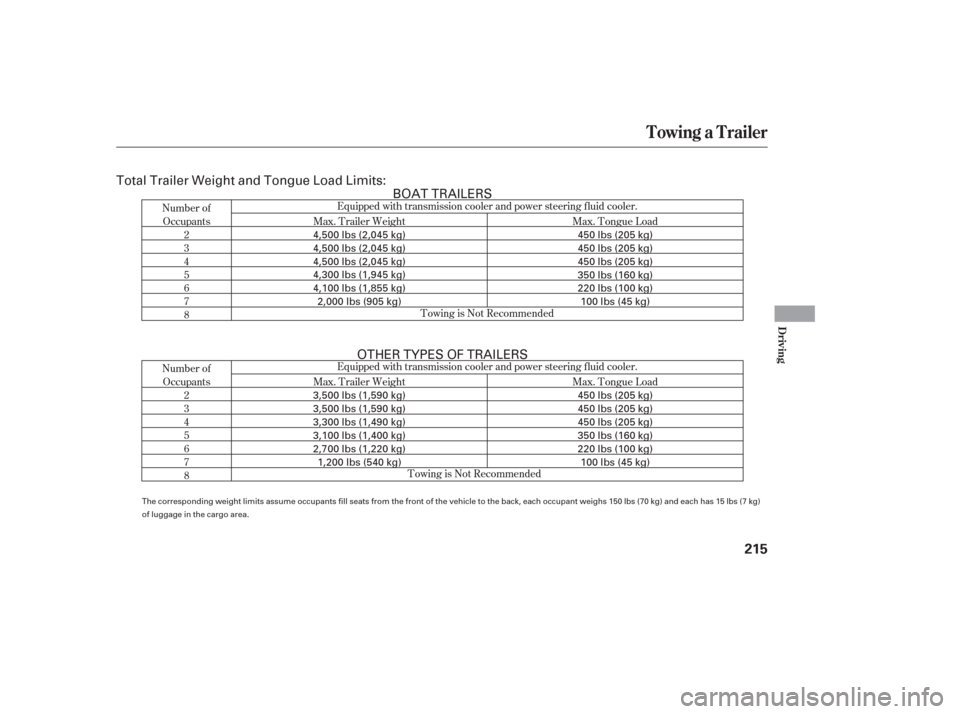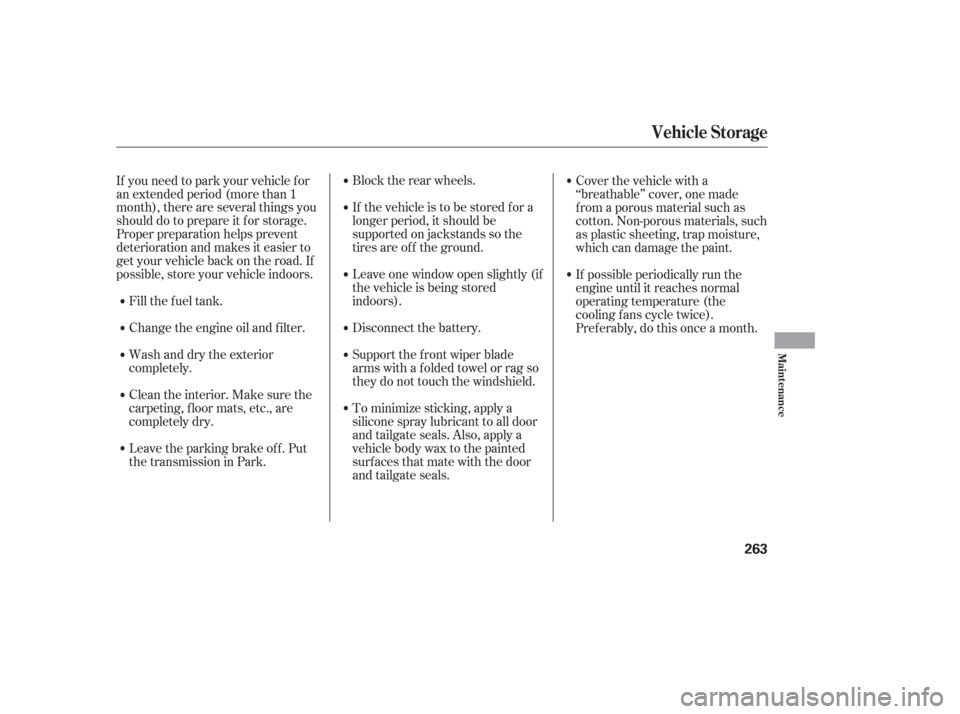Page 217 of 316

Number ofOccupants 2
3
4
5
6
7
8 Max. T railer Weight
Max. T ongue Load
Number of Occupants 2
3
4
5
6
7
8 Max. T railer Weight
Max. T ongue Load
Equipped with transmission cooler and power steering f luid cooler.
T owing is Not Recommended
Equipped with transmission cooler and power steering f luid cooler.
T owing is Not Recommended
Towing a Trailer
Driving
215
Total Trailer Weight and Tongue Load Limits: BOAT TRAILERS
OTHER TYPES OF TRAILERS
The corresponding weight limits assume occupants fill seats from the front of the vehicle to the back, each occupant weighs 150 lbs (70 kg) and each has 1 5 lbs (7 kg)
of luggage in the cargo area.
4,500 lbs (2,045 kg)
4,500 lbs (2,045 kg)
4,500 lbs (2,045 kg)
4,300 lbs (1,945 kg)
4,100 lbs (1,855 kg) 2,000 lbs (905 kg) 450 lbs (205 kg)
450 lbs (205 kg)
450 lbs (205 kg)
350 lbs (160 kg)
220 lbs (100 kg)
100 lbs (45 kg)
3,500 lbs (1,590 kg)
3,500 lbs (1,590 kg)
3,300 lbs (1,490 kg)
3,100 lbs (1,400 kg)
2,700 lbs (1,220 kg) 1,200 lbs (540 kg) 450 lbs (205 kg)
450 lbs (205 kg)
450 lbs (205 kg)
350 lbs (160 kg)
220 lbs (100 kg)
100 lbs (45 kg)
Page 236 of 316

�Ì�µ
�µ�µ
�µ
�µ �µ
U.S. Vehicles:
According to state and federal
regulations, f ailure to perf orm
maintenance on the items marked
with will not void your emissions
warranties. However, all
maintenance services should be
perf ormed in accordance with the
intervals indicated by the
inf ormation display. Youshouldcheckthefollowing
items at the specif ied intervals. If
you are unsure of how to perf orm
any check, turn to the appropriate
page listed.
Engine oil level Check every
time you fill the fuel tank. See
page .
Engine coolant level Check the
radiator reserve tank every time
you f ill the f uel tank. See page .
Automatic transmission Check
the f luid level monthly. See page .
Brakes Check the f luid level
monthly. See page .
Tires Check the tire pressure
monthly. Examine the tread f or
wear and foreign objects. See page . Lights Check the operation of
the headlights, parking lights,
taillights, high-mount brake light,
and license plate lights monthly.
See page .
189 189
246
258 248
244
Maintenance Minder
Maintenance,
replacement, or repair of
emissions control devices and
systems may be done by any
automotive repair establishment
or individual using parts that are
‘‘certif ied’’ to EPA standards. Owner’s Maintenance Checks
234
Page 240 of 316
Fluid Locations
238
RADIATOR CAP
ENGINE OIL DIPSTICK
(Orange loop)
BRAKE FLUID
(Gray cap)
WASHER FLUID
(Blue cap)
AUTOMATIC
TRANSMISSION
FLUID DIPSTICK
(Yellow loop)
POWER STEERING
FLUID (Red cap) COOLANT
RESERVOIR
ENGINE OIL FILL CAP
Page 247 of 316

�µ�µ
Put a new washer on the f iller bolt,
then reinstall the f iller bolt and
tighten it securely. Tightening
torque:
The dif f erential should be drained
and ref illed with new f luid according
to the time and distance recommen-
dations in the maintenance schedule.
In very high temperatures
(over 110°F, 43°C).
In very low temperatures
(under 20°F, 29°C).
Frequently tow a trailer.
Insert the dipstick all the way back
into the transmission.
The transmission should be drained
and ref illed with new f luid according
to the time and distance recommen-
dations in the maintenance schedule.
If you are not sure how to add f luid,
contact your dealer.
The timing belt should be replaced
according to the maintenance
message shown on the inf ormation
display. Replaced the belt at 60,000
miles (100,000 km) if you regularly
drive your vehicle in one or more of
these conditions:
Check the f luid level with the
dif f erential at normal operating
temperature and the vehicle sitting
on level ground. Remove the
dif f erential f luid f iller bolt and
washer, and caref ully f eel inside the
bolt hole with your f inger. The f luid
level should be up to the edge of the
bolt hole. If it is not, slowly add
VTM-4 Dif f erential Fluid until it
starts to run out of the hole.
6.
4WD models only
Timing Belt
Dif f erential Oil
A utomatic Transmission Fluid, Dif f erential Oil, Timing Belt
Maint enance
245
FILLER BOLT
CORRECT LEVEL
33 lbf·ft (45 N·m , 4.6 kgf·m)
Page 265 of 316

Fill the f uel tank.
Change the engine oil and f ilter.Block the rear wheels.
If the vehicle is to be stored f or a
longer period, it should be
supported on jackstands so the
tires are of f the ground.
Wash and dry the exterior
completely.
Cleantheinterior.Makesurethe
carpeting, floor mats, etc., are
completely dry.
If you need to park your vehicle f or
an extended period (more than 1
month), there are several things you
should do to prepare it f or storage.
Proper preparation helps prevent
deterioration and makes it easier to
get your vehicle back on the road. If
possible, store your vehicle indoors. Leave one window open slightly (if
the vehicle is being stored
indoors).Cover the vehicle with a
‘‘breathable’’ cover, one made
f rom a porous material such as
cotton. Non-porous materials, such
as plastic sheeting, trap moisture,
which can damage the paint.
Support the f ront wiper blade
arms with a f olded towel or rag so
they do not touch the windshield. Disconnect the battery.
Leave the parking brake off. Put
the transmission in Park. To minimize sticking, apply a
silicone spray lubricant to all door
and tailgate seals. Also, apply a
vehiclebodywaxtothepainted
surfaces that mate with the door
and tailgate seals.If possible periodically run the
engine until it reaches normal
operating temperature (the
cooling f ans cycle twice).
Pref erably, do this once a month.
Vehicle Storage
Maint enance
263
Page 309 of 316

CONT INUED
Engine....
Coolant Temperature Gauge . 71
Malf unction Indicator ................................
Lamp .62, 277
........
Oil Pressure Indicator . 62,276
..............
Oil, What Kind to Use . 239
...............................
Overheating .274
............................
Specif ications .289
............................
Speed Limiter .202
.......................................
Starting .199
.
Evaporative Emissions Controls . 293
...............................
Exhaust Fumes .57
Exhaust Gas Recirculation ........................................
System .294
Expectant Mothers, Use of Seat ........................................
Belts by .19
...............
Gas Mileage, Improving . 190
.........................................
Gasoline .186
...............
Fuel Reserve Indicator . 67
...........................................
Gauge .70
................
Octane Requirement . 186
........................
Tank, Filling the .187
................
Gas Station Procedures . 187Gauges
...
Engine Coolant Temperature . 71
...............................................
Fuel .70
GAWR (Gross Axle Weight .......................................
Rating) .214
GCWR (Gross Combined Weight .......................................
Rating) .214
............
Gearshif t Lever Positions . 200
........................................
Glove Box .99
GVWR (Gross Vehicle Weight .......................................
Rating) .214
.............
Halogen Headlight Bulbs . 248
.................
Hazard Warning Button . 77
...................................
Fan, Interior .106
.........................................
Features .105
....................
Filling the Fuel Tank . 187
Filters ...............................................
Oil .240
.............
Flashers, Hazard Warning . 77
...................
Flat Tire, Changing a . 267Fluids
..........
Automatic Transmission . 244
..........................................
Brake .246
..........................
Power Steering .247
................
Windshield Washers . 243
...................
Folding the Third Seat . 89
..........................
Four-way Flashers .77
.................................................
Fuel .186
...............................
Cap Message .72
......................
Fill Door and Cap .187
...........................................
Gauge .70
................
Octane Requirement . 186
........................
Reserve Indicator .67
........................
Tank, Filling the .187
.....................
Fuses, Checking the .279
Index
F GH
INDEX
III